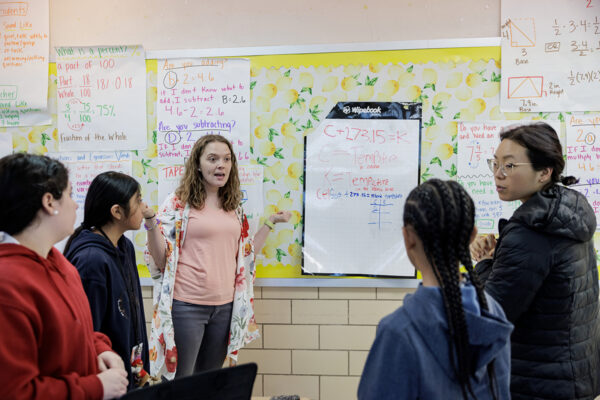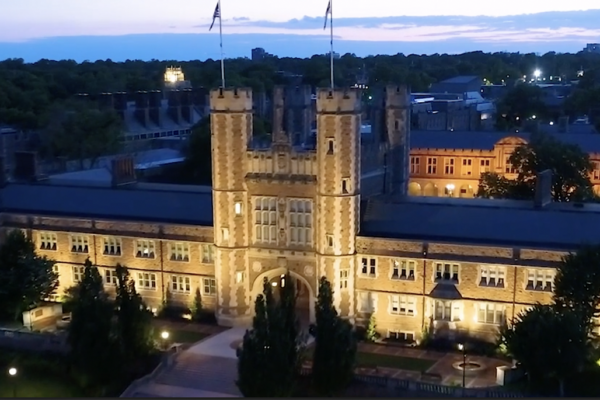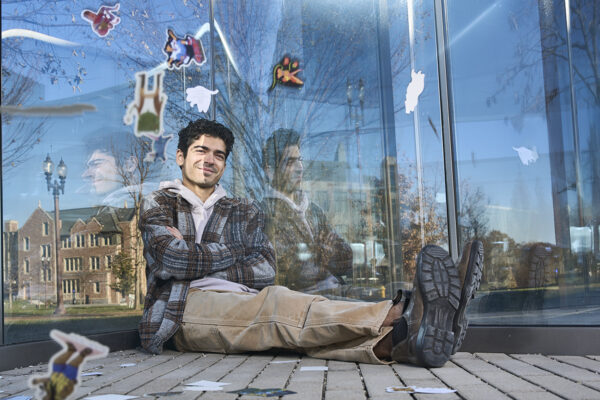After finishing up their own schoolwork, WashU students travel to local schools, community centers and hospitals to shed the label of student and assume the position of instructor, dance group leader, basketball coach and role model.
These undergraduate and graduate student volunteers are part of clubs committed to supporting the kids of St. Louis. Their projects range from teaching young hospital patients the fascinating — and slightly icky — science of slime, to introducing elementary students to the joys of dance, to helping high school students see themselves as future neuroscientists.
Here, the Record captures five of WashU’s many education groups as they get the next generation excited about learning.
(Videos: Tom Malkowicz/WashU)
Brain Discovery at Dewey International Studies Elementary School
When graduate students Taylor Pedersen and Haley Jetter put up a slideshow depicting a brightly colored diagram of a brain, hands shoot up across the classroom.
“Why does my head hurt when I look at the sun?”
“Why can I only remember some of my dreams?”
“Is my brain always on?”
Pedersen and Jetter are co-directors of the graduate student group Brain Discovery, which works with local elementary schools to help kids meet scientists and get excited about the process of scientific discovery.
For the students at Dewey International Studies Elementary School, that means looking at slices of a mouse brain under a microscope and an MRI of the human brain. Over the course of six sessions, the kids design and answer their own research question and even get the chance to hold a real human brain.
“It’s like at the dentist when they take a picture of my teeth,” one student observes while looking at the MRI. Pedersen nods, telling the kids that if a patient had braces, they would be visible on the scan, prompting some giggles.
By the end of the hourlong session, the students can point out their frontal lobe and occipital lobe.
“We don’t expect them to remember all of this information forever,” Jetter said. “But they’ll remember the feeling of being excited about it, which is really what matters.”
– Aliana Mediratta
Books and Basketball at KIPP Victory Academy
“Yes, yes, yes, yes!” David, an 8-year-old student at KIPP Victory Academy, cheers as his spaghetti-and-marshmallow tower, now architecturally sound, stands on its own. “I did it!”
This is the second activity in a jam-packed afternoon organized by Books and Basketball, a student organization that brings WashU students to schools for academic enrichment and recreational games. With over 100 members, Books and Basketball is one of the university’s largest volunteer organizations. Each week, volunteers visit three different sites in the St. Louis region.
Before the spaghetti-and-marshmallow building challenge, WashU senior Kyle Hinchey, club president, guided two third graders through a reading comprehension activity, analyzing a passage about a curious dog who likes to explore. Together, they answer a few questions and sketch a picture of the scene.
Next, the volunteers and students move to the gym to shoot hoops.
“I’m open!” sophomore William Meyer calls out to his team.
After a long school day and the additional tutoring, the children are eager to get their energy out through a fun game of basketball.
“Sometimes it can be difficult to create a mentorship relationship when you’re just sitting down and working with them, one on one, with their worksheet,” said Hinchey, who helped revive Books and Basketball in 2023, after the organization had taken a hit during the COVID-19 pandemic. “When you’re actually out there playing basketball with them, you see kids open up and really start to look up to you.”
– Amanda Young
St. Louis Area Brain Bee at WashU
By the time high school junior Shreenik Enturi faces the final question of the St. Louis Area Brain Bee, he has already successfully recalled what part of the brain functions as a circadian clock and explained the definition of excitotoxicity.
Now he has to identify two techniques that reveal the default mode network. Luckily for Enturi, who attends Fort Zumwalt South High School, the months he spent reading a brain facts book and compiling flashcards pay off. Holding his whiteboard up high, he correctly names PET scans and fMRI imaging — two technologies that were developed, in part, at WashU.
The annual neuroscience competition — organized by Erik Herzog, the Viktor Hamburger Distinguished Professor in Arts & Sciences, and Synapse, WashU’s student neuroscience club — aims to inspire high schoolers to get excited about careers in neuroscience.
“The Brain Bee was honestly the reason I became interested in neuroscience in the first place,” said Shriya Koneru, a WashU senior studying neuroscience and biology, in Arts & Sciences, who competed as a student at Ladue Horton Watkins High School. “It’s really cool to give high schoolers the opportunity to have the same kind of environment.”
With the national competition coming up, Enturi is relying on his tried-and-true flashcards to study, which he hopes will also come in handy when he goes off to college.
“I’ll be on the pre-med track,” Enturi said. “I want to be a psychiatrist one day.”
– Aliana Mediratta
Einstein Explorers at St. Louis Children’s Hospital
Nine-year-old Dash does not know what a non-Newtonian fluid is, but he does know what oobleck is. So he is thrilled when volunteers from the Campus Y’s Einstein Explorers arrive to teach him how to make his own.
“Ooooo-bleck,” shouts Dash, a long-term patient at St. Louis Children’s Hospital.
“First, we’re going to talk about the word viscosity, which is a big word for how goopy something is,” said WashU junior Sahil Soni.
Soni scoops a cup of cornstarch and Dash adds water. The mixture turns into a mushy quicksand. But when Dash presses hard on the oobleck, it transforms into solid.
“This is the best experiment so far,” exclaims Dash, who made a lava lamp and conducted an electricity experiment on previous visits.
In the past year, Soni has greatly broadened Einstein Explorers’ reach, increasing visits to the group’s four hospital partners and establishing new programs at three elementary schools. Cassidy Merano, certified child life specialist at St. Louis Children’s Hospital, appreciates the group’s sustained commitment.
“We want the kids to be kids while they are in hospital,” Merano said. “And they get to learn something while they are here.”
Next, the volunteers visit Amia, a prodigious 8-year-old who, in fact, is familiar with non-Newtonian fluids. Soni breaks out his Snap Circuits set and challenges Amia to see how high the fan blade will fly when powered by four batteries.
“Probably to the moon,” Amia said.
“Test it and find out,” Soni said. “That’s the best part about science.”
– Diane Toroian Keaggy
CityDance at Robinwood Elementary School
It is a rainy afternoon at Robinwood Elementary School, in the Ferguson-Florissant School District, but the atmosphere inside the building is lively and joyful as WashU senior Sara Lapidus and sophomore Sydney Shea lead students through a dynamic dance class.
Young dancers stretch to the sky, leap and skip across the floor and practice their “relevés,” i.e. walking on their tippy toes.
When Doja Cat’s “Say So” blasts on the speakers, a group assembles in the center of the gym to rehearse the choreography.
“I love this song,” says one 10-year-old. “I feel like Doja Cat songs were made for dancing.”
Lapidus and Shea are part of CityDance, a student organization established in 2017 by Emily Duggins (AB ’18, MFA ’24). Every week, CityDance volunteers visit five community centers and schools across the region to lead free, fun after-school programming.
“Our goal is to teach kids about confidence and creativity and to help them explore a new hobby and work on their collaboration skills,” said Lapidus, the club’s vice president. “At the end, when we make up dances, it’s really fun to watch them get engaged in the process. They get into the songs and work with each other to experiment and try different things.”
– Amanda Young


